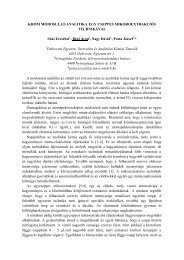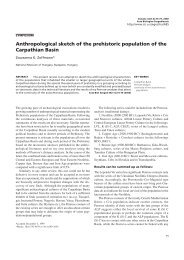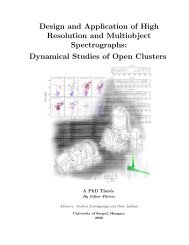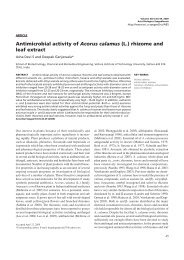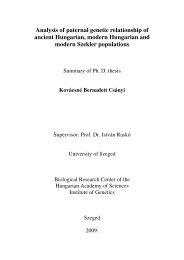principles of extraction and the extraction of semivolatile organics ...
principles of extraction and the extraction of semivolatile organics ...
principles of extraction and the extraction of semivolatile organics ...
You also want an ePaper? Increase the reach of your titles
YUMPU automatically turns print PDFs into web optimized ePapers that Google loves.
68 <strong>principles</strong> <strong>of</strong> <strong>extraction</strong><br />
Once <strong>the</strong> analyte has been extracted into phase B, it is usually desirable to<br />
reduce <strong>the</strong> volume <strong>of</strong> <strong>the</strong> extracting solvent. This can be accomplished with<br />
specialized glassware such as a Kuderna–Danish sample concentrator (Figure<br />
2.13b), which is widely used for concentrating <strong>semivolatile</strong> compounds<br />
dissolved in volatile solvents. The concentrator consists <strong>of</strong> three primary<br />
components held toge<strong>the</strong>r by hooks <strong>and</strong>/or clamps: a central flask with sufficient<br />
capacity to hold <strong>the</strong> extracting solvent, a tapered receiving vessel to<br />
contain <strong>the</strong> concentrated extract, <strong>and</strong> a distilling–condensing column that<br />
allows <strong>the</strong> solvent vapor to pass while retaining <strong>the</strong> analyte. The apparatus<br />
should be placed over a vigorously boiling water bath to ba<strong>the</strong> <strong>the</strong> central<br />
flask in steam. The solvent should <strong>the</strong>n be allowed to escape into a hood<br />
or recovered via an additional solvent recovery system. Alternatively, a<br />
mechanical rotary evaporator may be used to evaporate excess extracting<br />
solvent, or o<strong>the</strong>r evaporating units that evaporate solvent with an inert gas<br />
should be used.<br />
Performing LLE <strong>of</strong> analytes from drinking water is relatively straightforward.<br />
However, if your ‘‘aqueous’’ sample is blood, urine, or wastewater,<br />
<strong>the</strong> <strong>extraction</strong> process can become more tedious. Quite <strong>of</strong>ten in such<br />
samples, a scum forms at <strong>the</strong> layer interface, due to <strong>the</strong> presence <strong>of</strong> nonsoluble<br />
debris <strong>and</strong> <strong>the</strong> formation <strong>of</strong> emulsions. Analysts overcome this di‰culty<br />
using techniques such as adding salts, chilling <strong>the</strong> sample, or centrifugation.<br />
Applying a continuous LLE technique can be useful also.<br />
Continuous LLE is a variant <strong>of</strong> <strong>the</strong> <strong>extraction</strong> process that is particularly<br />
applicable when <strong>the</strong> distribution coe‰cient <strong>of</strong> <strong>the</strong> analyte between phases A<br />
<strong>and</strong> B is low. Additionally, <strong>the</strong> apparatus for conducting continuous LLE<br />
(Figures 2.14 <strong>and</strong> 2.15) automates <strong>the</strong> process somewhat. The analyst is<br />
freed from manually shaking <strong>the</strong> phases in a separatory funnel to e¤ect a<br />
separation allowing multiple <strong>extraction</strong>s to be performed simultaneously.<br />
Since <strong>the</strong> phases are not shaken to mix <strong>the</strong>m, this procedure also helps avoid<br />
<strong>the</strong> formation <strong>of</strong> emulsions. The apparatus can be assembled to perform<br />
<strong>extraction</strong> alone (Figure 2.14), or <strong>extraction</strong> <strong>and</strong> concentration (Figure<br />
2.15). The extractor performs on <strong>the</strong> principle that organic solvent cycles<br />
continuously through <strong>the</strong> aqueous phase, due to constant vaporization <strong>and</strong><br />
condensation <strong>of</strong> <strong>the</strong> extracting solvent. Continuous LLE apparatus designed<br />
for heavier-than-water or lighter-than-water extracting solvents is available.<br />
2.2.3. Procedures<br />
A general <strong>extraction</strong> scheme (Figure 2.16) can be devised to extract <strong>semivolatile</strong><br />
<strong>organics</strong> from aqueous solution such that important categories <strong>of</strong><br />
organic compounds (i.e., bases, weak acids, strong acids, <strong>and</strong> neutrals) are<br />
fractionated from each o<strong>the</strong>r <strong>and</strong> isolated in an organic solvent. Many










